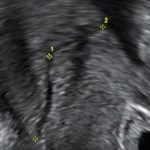1. Risk factors for incident cervical insufficiency (ICI) include history of cervical procedures, multi-fetal pregnancy, and number of miscarriages, although the strength of each risk factor varies depending on the parity of the pregnant patient.
2. For parous patients, PPROM and premature birth were risk factors for ICI, whereas macrosomia and prolonged second stage of labour were protective factors.
Evidence Rating Level: 3 (Average)
Incident cervical insufficiency (ICI) refers to a patient’s first presentation of a dilated cervix at an inappropriately early stage of pregnancy, particularly the 2nd trimester, and is a leading cause of late miscarriage and preterm birth. It is important to identify patients at risk of cervical insufficiency, as interventions such as cerclage must be done before the cervix is too dilated or short. Some risk factors for ICI have been identified, such as history of procedures on the cervix, history of late miscarriage or preterm birth, and polycystic ovarian syndrome. However, the difference in risk factors between nulliparous and parous women for ICI are unclear. Therefore, this case-control study based out of Sweden aimed to elucidate these differences by examining national health registries. In this study, ICI was defined as a diagnosis of cervical insufficiency or a cervical cerclage procedure, and a random sample of pregnancies without cervical insufficiency were collected in a ratio of 1:10 cases to controls. The study collected data including country of birth, body mass index, age, parity, multi-fetal gestation, previous miscarriages, previous pregnancy complications, and history of cervical procedures. In total, the study included 2257 pregnancies with ICI, with approximately two-thirds occurring in parous individuals. Several risk factors were identified and quantified through this study. For instance, cervical procedures were correlated with a two-fold increased risk for both nulliparous (OR 2.48, 95% CI 1.80-3.42) and parous (OR 1.82, 95% CI 1.38-2.38) individuals. For parous individuals, preterm prelabour rupture of membranes (PPROM) and preterm birth were associated with ICI (OR 2.93, 95% CI 2.29-.374 and OR 2.71, 95% CI 2.35-3.11 respectively), whereas macrosomia and prolonged second labour stage were associated with decreased risk of ICI (OR 0.72, 95% CI 0.63-0.82 and OR 0.83, 95% CI 0.73-0.95 respectively). As well, multi-fetal pregnancies were associated with ICI, but more so with nulliparous (OR 8.44, 95% CI 5.20-13.68) than with parous (OR 1.19, 95% CI 0.73-1.95) individuals. Previous miscarriages were also associated with a greater risk for ICI, but more so in nulliparous than parous individuals (OR 4.23, 95% CI 3.43-5.22 and OR 2.03, 95% CI 1.71-2.40 respectively, for 1 miscarriage), with a larger difference in risk between nulliparous and parous with a greater number of miscarriages (OR 34.57, 95% CI 21.60-55.31 and OR 6.67, 95% CI 4.93-9.02 respectively, for 3 miscarriages). Overall, this study identified important risk factors for ICI in both nulliparous and parous individuals, while also highlighting the differences in risks for these two subgroups, which can allow for early identification of pregnant patients who could benefit from cerclage and other interventions for cervical insufficiency.
Click to read the study in BMC Medicine
Image: PD
©2022 2 Minute Medicine, Inc. All rights reserved. No works may be reproduced without expressed written consent from 2 Minute Medicine, Inc. Inquire about licensing here. No article should be construed as medical advice and is not intended as such by the authors or by 2 Minute Medicine, Inc.


